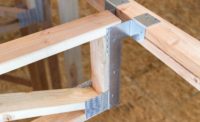Any building enclosure is susceptible to fire risk. Last year, approximately 99,000 commercial structure fires resulted in $2.6 billion in property damages. That’s an average of more than 271 per day, and trends are disturbing. In 2021, fires in factories increased by 129 percent between 2020 and 2021.
Fire codes help owners protect their buildings from property-destroying blazes. Those codes, however, are often set to a minimum standard for fire safety and are not always representative of best practices. One of those instances surrounds codes related to fire-rated floor doors.
The term “fire-rated floor door” has become synonymous for doors used in horizontal applications. There are, however, very different fire protection code distinctions for doors used in those applications. For building owners seeking to protect their entire building enclosure, it’s important to distinguish the codes and how they apply to fire-rated floor doors and fire-rated access doors.
Fire Resistance vs. Fire Protective
Building codes classify two types of doors for fire-rated openings in horizontal assemblies: fire-rated floor doors and fire-rated access doors. Each of these door types meet specific fire protection requirements for the applications in which they are installed.
The primary difference between these products is that fire-rated floor doors have a fire resistance rating while fire-rated access doors have a fire protective rating. The difference is critical to understand.
Fire-rated floor doors that are labeled “fire-resistant” are designed to contain the passage of smoke and flames per International Building Code requirements. These are only intended to confine fire for a set period. They are intended for installation in fire-rated floor assemblies but cannot be installed in fire-rated floor/ceiling assemblies according to building fire protection code requirements.
Fire-rated access doors meet a more exacting standard. They have a fire protective rating and are designed to prevent or retard the passage of excessive heat, hot gases, and flames over a period of time.
Products are designed with an intumescent fireproof coating on the underside of the cover and the inside of the frame to limit heat transmission in the event of a fire. This coating seals the opening to ensure that any combustibles stored on or near the door do not ignite due to excessive flame or heat transfer. Unlike fire-rated floor doors with a fire resistance rating, these products can be installed in fire-rated floor/ceiling assemblies to maintain a building’s fire code compliance.
Limiting Flame and Heat Transfer
Most fire doors are in a vertical plane and do not limit temperature transfer. The assumption is the door will be used for personal use and movement. The door must be clear on both sides. In a vertical assembly, temperature transfer is a secondary consideration.
Some builders and architects started incorporating fire-rated hatches into the floor assembly for equipment access, removal, and installation in a horizontal plane. The view of building owners is that fire protection can be achieved in those applications if they place signage or barriers to prevent items being stored on top of the door, believing that fire safety risks are mitigated. However, combustibles may be placed on the upper side of the door assembly, which could lead to a dangerous situation.
Intumescent Coating
To meet the heat penetration requirement, doors that limit both flame and heat are coated on the underside with an intumescent fireproof coating. The coating helps to passively increase a building’s resistance to fire. When exposed to extreme temperatures, the coating expands. The coating loses density as it expands and as a result acts as an insulator, sealing the opening in the event of a fire.
These doors are commonly available in smaller sizes to ensure safe and easy operation. The intumescent coating—which provides the critical difference to comply with fire protective codes—makes the doors much heavier and are therefore smaller to guarantee safe operation. Products are available in sizes up to 3’-6” x 3’-6” which generally meets most personnel and equipment access requirements inside of commercial buildings. The largest standard size doors weigh 368 pounds.
Most intumescent coatings use a variety of materials to limit heat release and flame propagation, including zinc borate, ammonium phosphate, melamine phosphate as an acid source and melamine and its derivatives as a blowing agent. Pentaerythritol derivatives are often used as char forming agents. The heaviness results from the expansion of the intumescent system—sometimes as much as 200 times the original thickness.
Floor doors with a fire-resistant rating are generally available in larger sizes as they do not meet the demanding ASTM or UL heat transfer test requirements required for a fire protection rating. While these larger access sizes may seem appealing to design professionals, the tradeoff is the reduced fire protection performance and the limited use in non-fire-rated floor/ceiling applications. Fire-rated access doors can be installed in both rated and non-rated floor/ceiling and roof/ceiling applications to maintain fire protection code compliance.
Critical Codes
There are variety of codes that apply to fire-rated applications. In addition, codes are currently being updated, which makes it difficult for architects and construction professionals to keep pace with the changes.
Among the most important codes are International Building Code 712.1.13.1 and IBC 712.1.13.2. In the first, the code reads “horizontal fire door assemblies” must “achieve a fire-resistance rating not less than the assembly being penetrated.” IBC 712.1.13.2 addresses access doors, and says they “shall be permitted in ceilings of fire-resistant floor/ceiling and roof/ceiling assemblies, provided that such doors are tested in accordance with ASTM E119 or UL 263 as horizontal assemblies”.
The critical language is in the commentary section of 712.1.13.2. It says “the standard fire test for doors (NFPA 80 or 257) is not acceptable. This ensures that that the thermal transmission through the access door and its effect on the assembly is considered.”
It is important to note that fire-rated floor doors that meet the fire-resistance rating are installed in floor assemblies. Floor access doors with the fire-protective rating are installed in floor/ceiling assemblies or ceiling/roof assemblies. Doors meeting the code requirements for access doors cannot be installed as a floor fire door, and similarly, floor fire doors may not be installed as an access door because they are tested to different standards.
NFPA 288 is another critical code and addresses “Standard Methods of Fire Tests of Horizontal Fire Door Assemblies.” It applies to horizontal fire door assemblies of various materials and types of construction that are installed in openings of fire resistance-rated floor systems or roofs to retard the passage of fire.
ASTM E119 tests building construction and materials, and UL 263 is the default standard for evaluating fire protection of structural steelwork. Both are also important for architects and builders to fully comprehend.
Where are They?
Fire-rated floor doors can be used in all commercial and institutional buildings, including office buildings, government centers, data centers, and transportation facilities. They are typically specified for use in computer rooms, equipment rooms, pump rooms, and elevator shafts in these facilities.
While fire-rated floor doors are vital to the safety of any building enclosure, they are also mostly indiscernible to building occupants.
One project illustrates the importance and limited visibility of the doors. In New York City, the $12 billion East Side Access project opened in 2022 after 16 years of construction. The heartbeat of the system lies within two 1,000-foot caverns, which includes 7,000 light fixtures, seven power stations and two off-track facilities. The East Side Access project accommodates 1.4 million daily train passengers who enter and exit the city from Long Island.
Deep within the caverns are 53 fire-rated floor access doors made by BILCO, the manufacturer of specialty access products. The doors range in size to 30” x 30” to 42” x 60”. BILCO’S doors are even more inconspicuous due to a pan cover that is designed to accept flooring materials for concealed access.
“BILCO doors are a product that the MTA knows and it’s easiest to purchase the known product,’’ said Jason Benfield of Tutor Perini, the civil engineering team working on the project. “BILCO is one of the major manufacturers of these doors. It’s easier to get something approved when it’s a product that is known to work in those applications.”
Raising the Bar
The differences between fire-resistant and fire-protective ratings may be subtle—the subject of heat transfer is a complicated science lesson and products with intumescent coatings are rare—but nonetheless important.
For building owners who seek to exceed standards for fire safety, it’s important to understand code requirements are set at the lowest performance levels legally allowed for construction.
Fire protection officials and codes can do much to help ensure safety. It is, however, up to the building owners, construction teams, architects, and specifiers to invest in and properly install the appropriate fire safety products as intended for a particular application.



